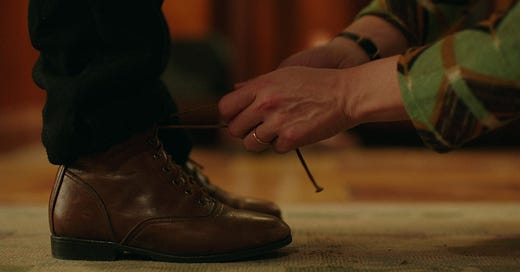JOJO BETZLER
I don’t... I don’t think I can do this.
ADOLF HITLER
What? Of course you can. Sure, you’re a little bit scrawny and a bit unpopular and you can’t tie your shoelaces even though you’re 10 years old, but you’re still the bestest, most loyal little Nazi I’ve ever met.
Nothing speaks quite as powerfully to the brilliance and success of Taika Waititi’s efforts to adapt Christine Leunens’s Caging Skies into the devastating, heartwarming JoJo Rabbit as his inspired use of shoes. Shoes, dancing at eye level, sometimes with their laces tied, sometimes untied, representing love, or death, or freedom, or hope.
Watching it for the umpteenth time, I am amazed at the mystifying emotional power it wields, even after repeated viewings. The moment when JoJo discovers his mother’s true character is an absolute gut-punch, even when you know it’s coming. The sequence where Stephen Merchant’s Kriminalkommissar Herman Deertz and his Gestapo goons arrive to search JoJo’s house starts out humorously, farcically enough, but quickly descends into terror—terror felt both by the film’s protagonists and by its audience. (Despite finding it so terrifying, I also love that sequence, paradoxically, for hinting at one of the film’s kindest gestures, the redemption of Captain Klenzendorf.)
And then, of course, there’s the final scene, set to David Bowie’s “Helden (Heroes);” the pitch-perfect musical (and lyrical) conclusion to a film that succeeds, inexplicably, in combining two dramatically different tones; often desperately different. I’m baffled at the audacity of putting Wes Anderson and Anne Frank in the same cinematic space, but I’m in awe at how well it actually works.
Well, to say it’s baffling and inexplicable isn’t quite accurate, I suppose. Because its the confidence and subtlety of Waititi’s Oscar-winning script that makes it all work. And yes, I just used the word “subtlety” when referencing a film written and directed by a self-described “Polynesian Jew,” featuring that same writer/director as an absurdist Adolf Hitler, young JoJo’s Betzler’s imaginary friend and confidant. But it is subtle, despite the ludicrousness of its premise, and on this latest viewing, I was particularly struck by just how well Waititi sprinkles his visual and conversational breadcrumbs into the first few acts.
To my mind, the most brilliant example of these thematic cairns is the way he uses the shoes and shoelaces. Rosie’s and Elsa’s shoes, so strikingly similar, visually, with their red toes and white bodies. The act of tying, from Rosie, as a sign to her son of her constant love and protection. JoJo, struggling and failing to tie Rosie’s shoes during the film’s most heartbreaking moment, and the beautiful symmetry of tying Elsa’s laces during its most gently joyful one. The way in which so many of the film’s scenes create an unusual contrast between the young boy’s face and his mother’s (or his young friend’s) shoes. Eye-lines and eyelets, because these characters say as much with their feet (and their actions) as they do with their mouths.
“How beautiful upon the mountains are the feet of him that brings good tidings, that publishes peace.”
Waititi doubles down on this imagery by littering the film with references to the power and importance of dancing—again, both visually and in the dialogue of his characters. Repeatedly, we see Rosie dancing, her red-and-white shoes tapping on the stairway wall or on the poolside tiles, just out of JoJo’s reach. One evening, when the two of them fight over the absence of JoJo’s father, Rosie impersonates her missing husband, growling at him: “Don’t just sit there. Come dance with your parents!”
“We have to dance to show God we are grateful to be alive,” she tells him, and when JoJo snarkily responds that “dancing is for people who don't have a job,” she chides him. “Dancing is for people who are free. It's an escape from all this. It’s what free people do.” While JoJo must grow up and learn to tie his own laces, must grow out of his desire to be the “bestest, most loyal little 10-year-old Nazi,” must come to appreciate the importance of his mother’s dancing, Elsa knows, instinctively, what dancing means. It is a sign of her autonomy and her resilience; a deliberate, seditious act; a way to be “a person” in a time and place striving to strip that personhood away from her. Dancing is both a sign of her freedom and the act that makes her free.
JOJO BETZLER
What's the first thing you'll do when you're free?ELSA KORR
Dance.
This is the third “breadcrumb” Waititi uses to lead his audience along the film’s emotional trail—the notion that evil must be overcome in the individual, not in society at large, because the best we can and must always do—the thing that is mostly likely to effect change, at least in us—is to do “what we can.”
When JoJo asks his mother what the freedom fighters hanging before the Nazi headquarters had done to be so brutally punished, she answers: “What they could.” When defending her actions to JoJo (in the persona of his father), she says “Take care of my Rosie for me. Can you do that? She’s doing what she can.” And when JoJo stands before his mirror for the last time, his understanding of himself and his place in the violent world around him has been changed forever, and immeasurably for the better.
In the opening moments, decked out in his full Hitler Youth glory, he told his ten-year-old self that “today you become a man.” In the closing scene, in civies, with all that the suffering of the last six months has taught him, he looks at his reflection with hope and says “Today... just do what you can.”









